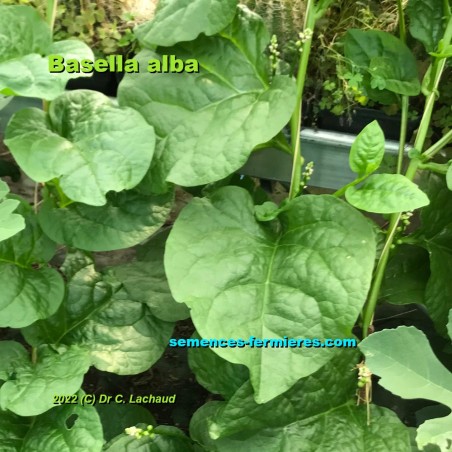





Basella alba - Malabar Spinach
1 packet of 20 seeds
-
Malabar Spinach is native to the tropical areas of East Africa, and widely distributed in all tropical areas of the planet, where it is grown as an ornamental plant and as a leaf green
Basella alba is a small vine, which stems rise on a support by rolling-up
In the wild, it is eaten by monkeys like Gorilla beringei and Cercopithecus mitis
Its broad leaves are green (purple or tinged with purple in some cultivars), fleshy, tender, and brittle, hairless, smooth for the smaller ones, or embossed for the larger ones.
They lend a beautifully lush to the plant
From the base of the leaves emerge ramifications, or most of the time inflorescences (from early summer until autumn)
The inflorescences are axillary spikes bearing globose, non-fragrant pink flowers above the foliage
The flowers quickly give way to fleshy berries, green, then black, which fall to the ground when ripe
Each berry contains 1 seed
| Jan | Feb | Mar | Apr | May | Jun | Jul | Aug | Sep | Oct | Nov | Dec | ||
|---|---|---|---|---|---|---|---|---|---|---|---|---|---|
Sow the Vine Spinach seeds in heat, sun, pots, at 0.5-1 cm deep, around April or May
Germination speed depends on temperature
Protect seedlings from snails and slugs
Transplant in the vegetable garden in June (earlier in warmer regions), in a fertile soil, rich in organic matter, and moist
Choose a location protected from:
Water regularly
Harvest the leaves throughout the whole season and according to plant capacity
Growth is slow in spring, but fast in summer : this tropical plant loves heat (optimal growth: 27°C)
Basella alba will grow all the best in warmth and fertile soil regularly watered
Indian Spinach is generally grown as an annual plant, because it is frost-tender
However, this perennial plant can regrow each year from its stump if protected from winter frost
You might also like
Payment :
PayPal < 150 €
Check < 850 €
Bank Wire > 149 €
Thank you for your kind understanding